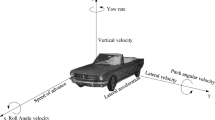Abstract
During the transportation of aquatic products, living states of the aquatic products and carbon emission of the carriers are respectively the concerns of the carrier enterprises and the government. Drivers adds virtual living states of aquatic products to the real driving environments through augmented reality technology to help themselves control oxygen contents and temperatures, and choose distribution routes. Furthermore, the effectiveness of carbon emission policy is investigated by simulating the impact of the policy on the distribution operations. In the simulation, the carriers take the minimization of overall costs of the distribution operations as the objective. In order to meet the requirements of carbon emission policies, factors of customer demands, road lengths and road congestion are used to determine the distribution. The simulation is implemented based on genetic algorithm: total costs are used as fitness values, and distribution sequences are encoded into chromosomes. And the carbon emission price is introduced as a operating parameter. Through running the simulation, we obtained the overall costs, carbon emission amounts and carbon emission costs. And a linear equation are fitted on the output data passed the reliability test. Based on the linear equation, it is concluded that the increase of the carbon emission price is helpful in reducing carbon emission amount, but it would greatly increase the operation costs of the carriers.






Similar content being viewed by others
References
Zhang, G., Habenicht, W., Ernst, L.S.W.: Improving the structure of deep frozen and chilled food chain with tabu search procedure. J. Food Eng. 60(1), 67–79 (2013)
Montanari, R.: Cold chain tracking: a managerial perspective. Trends Food Sci. Technol. 19(8), 425–431 (2008)
Arbelaitz, O., Rodriguez, C.: Comparison of systems based on evolutionary search and simulated annealing to solve the VRPTW problem. Int. J. Comput. Intell. Appl. 4(1), 27–39 (2004)
Ho, W., Ang, J.C., Lim, A.: A hybrid search algorithm for the vehicle routing problem with time windows. Int. J. Artif. Intell. Tools 10(3), 431–449 (2001)
Osvalda, A., Stirn, L.Z.: A vehicle routing algorithm for the distribution of fresh vegetables and similar perishable food. J. Food Eng. 85(2), 285–295 (2008)
Wu, Z.: Optimization of distribution route selection based on particle swarm algorithm. Int. J. Simul. Model. 13(2), 230–242 (2014)
Dhakal, S.: Urban energy use and carbon emissions from cities in China and policy implications. Energy Policy 37(11), 4208–4219 (2009)
Cardona-Valdés, Y., Álvarez, A., Ozdemir, D.: A bi-objective supply chain design problem with uncertainty. Transp. Res. C 19(5), 821–832 (2011)
Su, M., Li, R., Lu, W.: Evaluation of a low-carbon city: method and application. Entropy 15(4), 1171–1185 (2013)
Bloemhof-Ruwaard, J., Dekker, R., Fleischmann, M., et al.: Quantitative models for reverse logistics: a review. Eur. J. Oper. Res. 103(1), 1–17 (1997)
Hoen, K.M.R., Tan, T., Fransoo, J.C., van Houtum, G.J.: Effect of carbon emission regulations on transport mode selection under stochastic demand. Flex. Serv. Manuf. J. 26, 170–195 (2014)
Zhang, L., Wang, Y., Fei, T., Ren, H.: The research on low carbon logistics routing optimization based on DNA-ant colony algorithm. Discrete Dyn. Nat. Soc. 10, 1–13 (2014)
Benjaafar, S., Li, Y., Daskin, M.: Carbon footprint and the management of supply chains: insights from simple models. IEEE Trans. Autom. Sci. Eng. 10(1), 99–116 (2013)
Hu, H., Li, Y.: Research on routing optimization of regional logistics based on gravity model: a case of blue and yellow zones. iBusiness 5(4), 167–172 (2013)
Hummels, D.: Transport costs and international trade in the second era of globalization. J. Econ. Persp. 21(3), 131–154 (2007)
Gonzales, D., Searcy, E.M., Eksiku, S.D.: Cost analysis for high-volume and long-haul transportation of densified biomass feedstock. Transp. Res. Part A 49, 48–61 (2013)
Tseng, Y., Yue, W.L., Taylor, M.: The role of transportation in logistic chain. Proc. Eastern Asia Soc. Transp. Stud. 5, 1657–1672 (2005)
Lu, C., Tong, Q., Liu, X.: The impacts of carbon tax and complementary policies on Chinese economy. Energy Policy 38(11), 7278–7285 (2010)
Grema, L.U., Abubakar, A.B., Obiukwu, O.O.: Carbon emission control measures. Int. Lett. Nat. Sci. 3, 21–27 (2013)
Holland, J.H.: Studying complex adaptive systems. J. Syst. Sci. Complexity 19(1), 1–8 (2006)
Liu, Z., Sun, Z.: The carbon trading price and trading volume forecast in Shanghai city by BP neural network. World Acad. Sci. Eng. Technol. 11(3), 623–629 (2017)
Acknowledgements
This work is supported by National Science Foundation of China (Grant: 71203162), Science and Technology Planning Project of Guangdong Province (Grant: 2014B040404072), Natural Science Foundation of Guangdong Province (Grant: 2015A030313642), Innovation Project of Wuyi University (Grant: 2014KTSCX128 and 2015KTSCX144).
Author information
Authors and Affiliations
Corresponding author
Rights and permissions
About this article
Cite this article
Peng, M., Yang, F. Effect of carbon emission policy on fresh aquatic product carriers in augmented reality respective: a parallel simulation research based on genetic algorithm. Cluster Comput 22 (Suppl 6), 15335–15345 (2019). https://doi.org/10.1007/s10586-018-2593-1
Received:
Revised:
Accepted:
Published:
Issue Date:
DOI: https://doi.org/10.1007/s10586-018-2593-1




